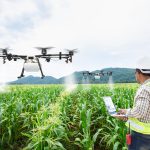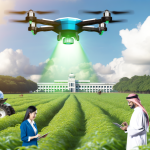Imagine a world where your chickens are healthier, your farm is more efficient, and your profits are soaring. Welcome to the realm of smart poultry farming, a growing trend that’s transforming how you manage your flock.
This isn’t just about feeding your birds; it’s about optimizing every aspect of your poultry operation with cutting-edge technology. You might wonder if this is the future of farming or just a passing fad. But what if embracing this trend could revolutionize your farm, save you time, and increase your bottom line?
Dive into this article to discover how smart poultry farming can change the game for you and your feathered friends.

Technologies In Smart Poultry
Smart poultry farming is gaining popularity with advanced technologies improving efficiency. Automated feeders and climate control systems enhance bird health and productivity. Farmers now use data analytics for better decision-making, ensuring optimal growth conditions and reducing waste.
Smart poultry farming is rapidly transforming the agricultural landscape, bringing innovative technologies that enhance efficiency and productivity. Imagine a farm where every aspect is monitored and optimized using advanced tools. These technologies are not just futuristic dreams; they are here, making poultry farming more sustainable and profitable.Automated Feeding Systems
Automated feeding systems ensure your poultry gets the right amount of nutrition at the right time. These systems reduce waste and save time. With sensors and data analytics, you can precisely control feed distribution based on the birds’ age and health needs. Have you ever thought about the time saved by not manually feeding your birds daily? It’s substantial!Environmental Monitoring
Monitoring the environment is crucial for poultry health. Advanced sensors track temperature, humidity, and air quality in real-time. If the conditions go beyond the optimal range, alerts are immediately sent to your smartphone. This technology prevents diseases and keeps your poultry comfortable. How much healthier would your birds be with perfect living conditions?Blockchain For Traceability
Blockchain technology offers transparency and traceability from farm to table. It records every step of the poultry production process, ensuring quality and safety. Consumers can scan a QR code to know the farm’s history, feeding practices, and health records of the poultry. Wouldn’t you want to guarantee your customers the best quality?Data Analytics For Productivity
Data analytics help you understand patterns and trends in poultry behavior and health. By analyzing this data, you can make informed decisions to improve productivity. You’ll be able to predict issues before they arise, optimize feed conversion ratios, and even forecast market demands. Are you ready to make data-driven decisions to boost your farm’s efficiency?Drones For Surveillance
Drones offer a bird’s eye view of your farm, allowing you to monitor large areas quickly. They can identify potential threats such as predators or infrastructure issues. Imagine how much easier it would be to oversee your farm’s operations from above! Drones enhance security and streamline management, making your job less stressful. Adopting these technologies in smart poultry farming isn’t just about keeping up with trends; it’s about creating a more efficient and profitable operation. With each innovation, you gain more control and insight into your farm’s processes. So, which technology will you embrace to elevate your poultry farming practices?Benefits Of Smart Poultry Farming
Smart poultry farming offers a range of benefits for farmers and consumers alike. With the integration of technology, this modern approach enhances productivity and efficiency in poultry operations. Utilizing advanced systems, farmers can monitor and manage their flocks more effectively, ensuring healthier birds and higher yields. This section explores the key advantages of smart poultry farming, highlighting how it contributes to a more sustainable and profitable agricultural practice.
Enhanced Animal Health Monitoring
Smart technology allows constant monitoring of poultry health. Sensors track vital signs and behaviors. Early detection of issues prevents widespread disease. This leads to healthier flocks and reduced mortality rates.
Improved Feed Efficiency
Automated systems optimize feed distribution. Birds receive precise amounts based on their needs. This reduces waste and costs, increasing profitability. Efficient feeding schedules enhance growth rates and overall productivity.
Reduced Labor Costs
Technology automates many manual tasks. Farmers spend less time on routine duties. This cuts labor costs significantly. Focus shifts to strategic management and expansion opportunities.
Environmentally Friendly Practices
Smart farming minimizes environmental impact. Efficient resource use reduces carbon footprint. Systems control water and energy consumption. These practices support sustainable farming goals.
Data-driven Decision Making
Farmers access real-time data for informed decisions. Analytics help track trends and patterns. Insights improve operational strategies and outcomes. Data-driven approaches enhance overall farm management.
Challenges And Solutions
Smart poultry farming is gaining popularity worldwide. This trend introduces innovative technology to traditional farming methods. Yet, it also presents challenges. Farmers face obstacles like high costs, technical issues, and data management. These challenges require practical solutions to ensure efficiency and success.
Cost And Investment Challenges
The initial cost of smart technology can be high. Many small farmers struggle to afford it. This hinders their ability to modernize. Financial support from governments or grants can help. Offering loans with low interest rates can also ease the burden.
Technical Issues And Maintenance
New technology often brings technical problems. Farmers may find it hard to fix these issues. Regular training sessions can educate them. Access to technical support is crucial. This ensures quick problem-solving, reducing downtime and losses.
Data Management Complexity
Smart farming generates large amounts of data. Managing this data can be complex. Farmers need simple tools to analyze and use it effectively. User-friendly software can simplify data management. Training programs can teach farmers to interpret data insights.
Resistance To Change
Some farmers resist adopting new methods. They may fear the unknown. Educating them on benefits can change their mindset. Demonstrating real-world success stories builds trust. Encouraging small-scale trials can help ease their fears.

Future Of Poultry Farming
Smart poultry farming is transforming the industry with new technologies. Farmers use sensors and data to optimize care and productivity. This trend helps in monitoring bird health and improving farm efficiency.
The future of poultry farming is taking a bold leap into the digital age with smart technology at its helm. As more farmers embrace these innovations, poultry farming is becoming more efficient, sustainable, and profitable. Whether you’re a seasoned farmer or just curious about this trend, there’s no denying the significant impact technology is having on the industry.The Role Of Technology In Poultry Farming
Technology is transforming how we manage poultry farms. Automated systems now monitor everything from temperature to feed levels. This means you can ensure optimal conditions for your flock without constantly being present. Imagine having a system that alerts you when something’s off. No more guessing or constant manual checks. These technologies save time and reduce errors, leading to healthier birds and higher yields.Sustainability And Smart Farming
Smart poultry farming isn’t just about efficiency; it’s about sustainability. By using resources more wisely, you reduce waste and environmental impact. Automated feeding systems, for instance, ensure that feed is used effectively, minimizing excess. Sustainable practices aren’t just good for the planet. They also boost your farm’s reputation and appeal to eco-conscious consumers. Are you ready to make your farm a model of sustainability?Challenges And Solutions In Smart Poultry Farming
Adopting new technology can be daunting. You might worry about costs or the learning curve. However, many solutions are scalable, meaning you can start small and expand as you grow more comfortable. Training is key. Many providers offer user-friendly interfaces and support to help you get the most out of your investment. Have you considered attending workshops or seeking advice from other tech-savvy farmers?Data-driven Decisions For Better Outcomes
Data is the backbone of smart farming. With precise data on flock behavior, you can make informed decisions quickly. This leads to better health management and productivity. Consider a system that tracks bird growth and health metrics. Such data can help you spot trends and address issues before they escalate. How might this data-driven approach change the way you manage your farm?Embracing The Change
Change is never easy, but it’s often necessary for growth. Embracing smart farming technology could be the step that elevates your poultry farm to new heights. As you explore these innovations, remember that even small changes can make a big difference. The future of poultry farming is here. Are you ready to embrace it?
Conclusion
Smart poultry farming is reshaping agriculture. It offers new opportunities and solutions. Farmers can now increase productivity with less effort. Technology supports better animal welfare and efficient resource use. This modern approach reduces waste and improves profits. Adopting smart techniques leads to more sustainable practices.
As the trend grows, it promises a brighter future for farmers. Embracing change ensures staying ahead in the market. Smart poultry farming is not just a trend; it’s the future of agriculture. Farmers who adapt will see long-term benefits. The time to innovate is now.



